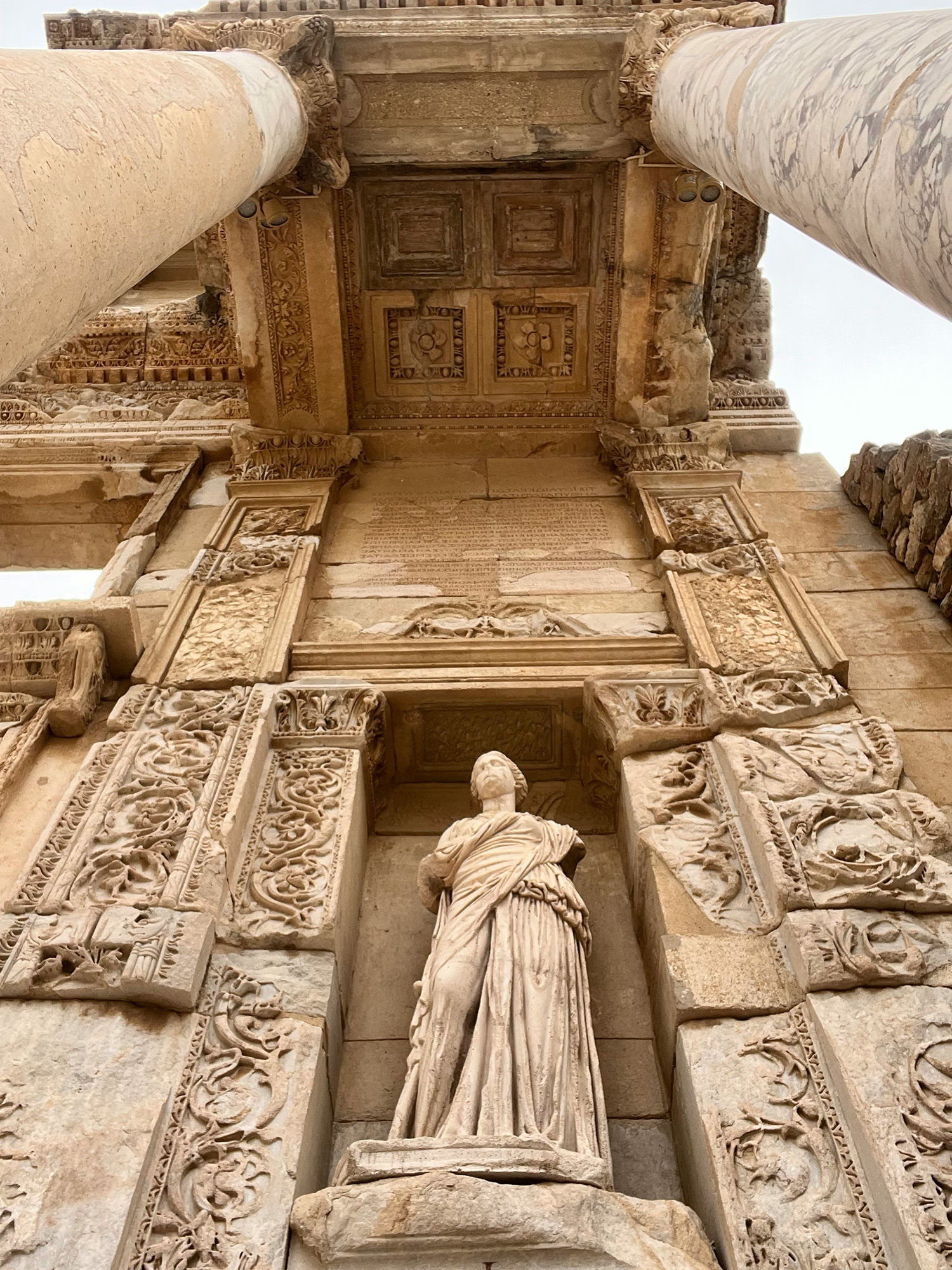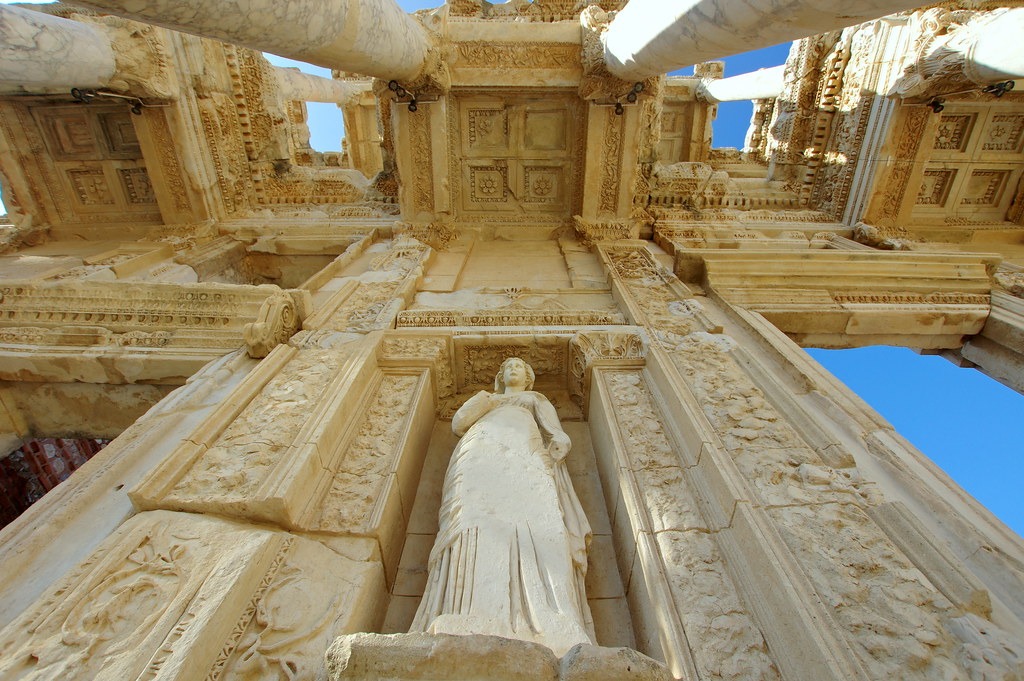Nestled within the sunlit ruins of Ephesus, in modern-day Turkey, stands one of antiquity’s most awe-inspiring architectural marvels—the Library of Celsus. A masterpiece of Roman design and devotion, this elegant structure remains not only a symbol of ancient scholarship but also a lasting monument to the bond between knowledge, power, and remembrance.
A Monument Built from Love and Legacy

The library was commissioned in the early 2nd century AD by Gaius Julius Aquila, a wealthy Roman consul, in honor of his father, Tiberius Julius Celsus Polemaeanus—a distinguished senator, scholar, and former governor of Asia. Celsus was deeply respected throughout the Roman Empire for his intellect and public service, and in a rare tribute for a Roman official, his tomb was placed beneath the library’s main chamber—a sacred space where learning and legacy would coexist for eternity.
Completed around 117–120 AD, the Library of Celsus was both a mausoleum and a temple of wisdom, designed to immortalize its namesake through the preservation of knowledge.
Architectural Brilliance: The Facade of Wisdom
The library’s striking façade, meticulously reconstructed in the 1970s after centuries of ruin, stands as one of the finest examples of Roman imperial architecture in the eastern provinces. Its symmetrical design and commanding presence immediately capture the eye—two stories of Corinthian and Ionic columns rise in graceful harmony, framing arched niches that once held statues representing the four cardinal virtues:
- Sophia (Wisdom)
- Arete (Virtue)
- Ennoia (Intellect)
- Episteme (Knowledge)
These personifications remind visitors that the pursuit of wisdom was not merely academic but deeply moral—a journey of both the mind and spirit. The interplay of columns, cornices, and sculptural reliefs gives the illusion of greater height, a technique that epitomizes the Romans’ mastery of perspective and proportion.
The Heart of a City of Scholars

In its prime, the Library of Celsus was among the largest and most renowned libraries of the ancient world, rivaling the great libraries of Alexandria and Pergamum. It reportedly housed over 12,000 scrolls, meticulously arranged in wooden cabinets along the inner walls.
The reading rooms were ingeniously designed to protect these precious manuscripts: double walls and hollow spaces between them insulated against humidity and extreme heat, a feat of ancient engineering that demonstrates the sophistication of Roman architectural planning.
Beyond its function as a library, the building served as a cultural and intellectual hub within Ephesus—then one of the Roman Empire’s most prosperous cities. Scholars, philosophers, and officials gathered here, exchanging ideas that bridged East and West, science and philosophy, politics and art.
A Tomb Beneath Knowledge
Perhaps the library’s most profound feature lies hidden beneath its marble floor. The sarcophagus of Celsus rests in a crypt directly under the main entrance hall—a rare honor in Roman tradition, as burial within city limits was typically forbidden. This unique arrangement symbolized the merging of earthly fame and eternal wisdom.
In death, Celsus became one with the knowledge he had revered in life—his body entombed in the same structure that preserved the wisdom of the ages. The library’s dual purpose as both a repository of learning and a sepulcher of honor made it an enduring symbol of Roman ideals: intellect, virtue, and immortality.
A Testament to Ephesus’ Golden Age
Ephesus, once a bustling port city and the capital of the Roman province of Asia, flourished as a center of commerce, religion, and culture. The Library of Celsus stood proudly near the city’s main thoroughfare, the Curetes Street, facing the morning sun—a daily reminder of enlightenment rising over the empire.
Behind its façade stretched a rectangular reading hall, illuminated by natural light streaming through tall windows. The design created an atmosphere of reverence and quiet reflection, as though one were entering a temple of thought.
Rediscovery and Restoration
Centuries of earthquakes and invasions took their toll on the library, reducing much of it to rubble by the Middle Ages. The façade collapsed around the 10th or 11th century, its grandeur lost to time. Yet, archaeological excavations in the 20th century resurrected the monument piece by piece, using original fragments and careful reconstruction.
The restoration, completed in 1978, remains a triumph of archaeological precision. The façade’s towering columns, intricate capitals, and decorative reliefs now once again overlook the marble streets of ancient Ephesus—reminding the world of a civilization that valued wisdom as much as power.
Symbolism and Modern Significance
Today, the Library of Celsus stands as more than an archaeological treasure—it is a universal symbol of knowledge and cultural continuity. Its surviving façade reflects the eternal dialogue between life and learning, art and intellect, mortality and legacy.
Visitors who stand before it are often struck by the same feeling of awe that ancient citizens of Ephesus must have felt centuries ago. The sunlight dancing on the marble, the silent grandeur of the statues, and the knowledge that beneath one’s feet lies the tomb of a scholar—all combine to create an atmosphere of timeless reverence.
The library continues to inspire architects and historians worldwide. Its façade has influenced neoclassical designs across Europe and America, from museums to courthouses, carrying echoes of Ephesus’ wisdom into the modern age.
Legacy of Eternal Knowledge
In many ways, the Library of Celsus encapsulates the very essence of Roman civilization—the harmony between beauty and function, intellect and immortality. It remains a rare example of how one man’s devotion to his father’s legacy became a monument to humanity’s collective pursuit of understanding.
More than 1,900 years after its construction, the Library of Celsus still speaks—a marble poem written to the power of memory, learning, and love. Standing before it, one cannot help but feel that in honoring knowledge, the Romans achieved their own form of eternity.
Sources:
- UNESCO World Heritage Centre – Ancient City of Ephesus
- Turkish Ministry of Culture and Tourism – The Library of Celsus
- American Journal of Archaeology – “Architectural Reconstruction of the Celsus Library, Ephesus”
- National Geographic History – “Ephesus: The City of Marble and Memory”
